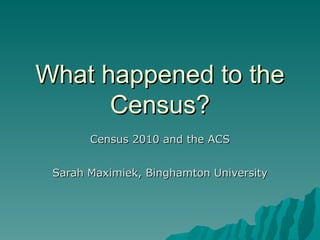What happened the Census?
- 1. What happened to the Census? Census 2010 and the ACS Sarah Maximiek, Binghamton University
- 2. Decennial Census Mandated in the Constitution 1790 ŌĆō First Census 1900 - Decennial Census tracked employment, social and agricultural counts 1902 ŌĆō Census Bureau established as permanent agency
- 3. Census 2000 and earlier Short Form DOB, gender, Hispanic Orgin (universally asked in 1980), Race, Identifying Information, Housing Ownership Based on people ŌĆō one answer per person. Data widely available, distributed throughout most datasets
- 4. Census 2000 and earlier Long form Varies considerably in length, depending on Census year Asks the respondent a variety of social, economic and demographic questions (education, citizenship, income source, language spoken at home, transportation to and from work, etc.), including short form questions Sample ŌĆō given to a small percentage of the population
- 5. Census 2010 (and beyond) Will consist of the short form questionnaire only Information collected is what is required by Constitution (enumeration for representation) The American Community Survey will fill in data left out of the long form
- 6. American Community Survey (ACS) What is it? First done in 2005 Complied demographic data for areas of at least 65,000 people Based on sampling Based on addresses, not people
- 7. ╠²
- 8. ACS
- 9. ACS Areas of 20,000 or more people will be updated with 3 year period averages. For areas less then 20,000 people, data will cover 5 year period averages .
- 10. ACS data release example average 1/05-12/07 1/06-12/08 Dec 2008 Dec 2009 EtcŌĆ” Binghamton City (47,380) sample average Data included 1/05-12/05 Previous 12 mos. 2006 (1 st ACS test) should be updated annually after Census2010 Broome County (200,536) 1/05-12/09 1/06-12/10 2010 2011 etcŌĆ” Johnson City (15,535) Dates Covered Release Dates Place
- 11. Why the ACS? Congress has failed to consistently fund mid-Census surveys Spreads data gathering over long-term Allows Decennial Census to focus on compiling an accurate headcount Removes ŌĆ£contentŌĆØ from Decennial Census More frequently updated data
- 12. What the ACS is notŌĆ” A substitute for Current Population Surveys Substitute for Small Area Income and Poverty Estimates
- 13. Census vs ACS Residency Census: asks residents for ŌĆ£usual place of residence.ŌĆØ ACS: asks for ŌĆ£current place of residence,ŌĆØ as defined as living there for the past two months Group quarters are treated differently, depending on question
- 14. Census vs ACS Point in Time data vs Estimates Census: data collected is either headcount or sample as of ŌĆ£Census DayŌĆØ (April 1) of the Census Year. ACS: with the introduction of ACS, the data available can be Point-in-time and/or a summary of data collected over a period of time
- 15. Census vs ACS Income Census: Asks for data in early April when people have tax information in mind. ACS: people will be asked to estimate income over a 12 month period that is not Jan-Dec ACS: also must account for changes in dollar value over a multi-year period
- 16. Census vs ACS Margin of Error Census: Users were not told margin of error on data charts ACS: 10% error margin, charts show lower and upper margins.
- 17. Comparison of data sets Census 2010 data and earlier Census short form data can be compared* ACS data across geographic areas can be compared if the time frames are the same (Annual to annual, 3 yr to 3 yr) *as much as similar data sets from Census to Census could ever be compared, anyway
- 18. Comparison of Data Sets Comparison between ACS and Long Form Census data Varies, must consider: ACS data collected monthly, Census data reflects information as of April 1. What does this mean for that variable? Changes in rules (residency, group homes) can effect areas that have many institutions. Is the number an average, as opposed to a sample? What is the error rate?
- 19. Questions?


















